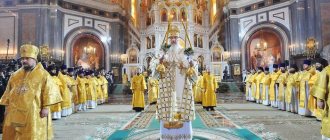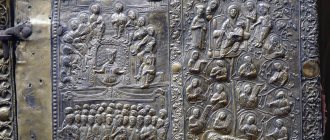At the bookshelf (for children). Church Slavonic language for children. Tutorial
Audio
He is the most prayerful in the world,
He arose by the will of God,
The language of our wondrous Psalter
And patristic books,
He is a royal decoration
A spring of living grace,
The Lord's comfort to us
These words of monk Lazar (Afanasyev) open the book that we present to your attention today. It is called “Church Slavonic language for children. Tutorial".
2. As the publishers say, the ancient Slavic alphabet was created more than a thousand years ago, when the Slavic tribes turned from the darkness of paganism to the light of Christian teaching. In 862, an embassy from the Slavic principality of Moravia, from Prince Rostislav, arrived to the Byzantine Emperor Michael III with a request to send teachers who would translate Christian worship into a language understandable to the Slavic people and who could explain the essence of Christian teaching in their native Slavic language. Many of the Slavs had already accepted Christianity from the Roman Church by that time. But they did not understand the service because it was conducted in Latin. Latin speech was alien to the Slavs, and they were forced to turn to Byzantium for help.
3. This is how the Monk Nestor the Chronicler writes about this event in The Tale of Bygone Years. This work is a monument of ancient Russian literature and a historical document that, through the centuries, has brought to us information about the most important historical events. “When the Slavs were already baptized, their princes Rostislav, Svyatopolk and Kotsel sent to Tsar Michael, saying: “Our land is baptized, but we do not have a teacher who would instruct and teach us, and explain the Holy Books: for we do not know Greek language, not Latin. Some teach us this way, and others teach us differently, so we don’t know either the shape of the letters or their meaning. And send us teachers who could tell us about book words and their meaning. "
4. Hearing this, Tsar Michael summoned all the philosophers and conveyed to them everything that the Slavic princes had said. And the philosophers said: “There is a man in Thessaloniki named Leo. He has sons who know the Slavic language; His two sons are skilled philosophers.” Hearing about this, the king sent for them to Leo in Thessaloniki with the words: “Send to us without delay your sons Methodius and Constantine (Cyril).” Lev soon sent them. And they came to the king, and the king said to them: “The Slavic land sent ambassadors to me, asking for a teacher who could interpret the sacred books for them. Because that's what they want." And the king persuaded them and sent them to the Slavic land to Rostislav, Svyatopolk and Kotsel. When these brothers arrived, they began to compile the Slavic alphabet and translated the Apostle and the Gospel. And the Slavs were glad that they heard about the greatness of God in their language.”
7. The Church Slavonic language also occupies an important place in Russian culture. It is the basis of the Russian literary language, the source of its richness and beauty. An outstanding thinker, Minister of Public Education, Admiral A. S. Shishkov wrote: “. the Slavic language is the root and foundation of the Russian language; he gives him wealth, intelligence, strength and beauty. He is lofty and magnificent in depicting important objects, and sweet and simple in describing ordinary things. Slavic is a high, learned, bookish language. No other Church has such a treasure as we have. “Our task, the publishers note, is to preserve the Church Slavonic language as an integral part of Orthodox culture and also pass it on to future generations.
Source
Complete Church Slavonic Dictionary
- A
- B
- IN
- G
- D
- E
- AND
- S
- Z
- AND
- I
- TO
- L
- M
- N
- O
- P
- R
- WITH
- T
- U
- F
- X
- T
- C
- H
- Sh
- SCH
- E
- YU
- I
- Z
- X
- P
- F
- V
If you notice an error, highlight it and press Ctrl+Enter
Like
< Previous | Aar | Avs | Aen | Ale | Ama | Ann | Apr | Art | Asi | More | Next >
| Word | Transcription | Interpretation |
| gar0n | Aaron | Mountain, consecrated (Heb.) first high priest rep. people who lived 1638-1515. BC; he was the son of Amram and Jochebed, 3 years older than his brother, the prophet Moses |
| Gar0n r0d | Aaron genus | Aaron is the elder brother of Moses, who spoke for him before Pharaoh, and after the construction of the tabernacle, he was anointed high priest. The high priestly dignity was to be hereditary in the family. Therefore, R.A. used in Scripture as the priestly class |
| Moreover | Abache | however, however, but |
| Ґbessinіz | Abessinia | Ethiopia |
| Abetsadlo | Abetsadlo | Seven Latin letters expressing sounds in musical and singing techniques |
| Abi2dnyn | Abidnyn | Offended (Old Russian) |
| ЃБіе | Abie | Soon, immediately, suddenly; by the way, it's favorable |
| Gblan | ablan | Apple tree |
| Abo | Abo | or, whether |
| Absida | apse | altar semicircle with high place |
| Abyz | Abyz | A Muslim clergyman is sometimes used instead of a mullah in Russian monuments. |
| Abykh | either way | so that, if, whenever |
| Gbye | Abye | immediately, immediately, suddenly |
| Gwaddwn | Abaddon | Destroyer (Heb.), Angel of the Abyss (Greek) |
| Gvana | Avana | A river in Syria that irrigates the city of Damascus |
| Ґvarjm | Avarim | A mountain memorable for the fact that the prophet Moses was buried on it. Otherwise it is called Navav |
| Gvara | Avars | Turkic tribe |
| Let's go | avat | abbot, abbot |
| Ѓвва | Ava | A title given to the leaders of the monastery, as seen in the lives of the saints. In the New Testament this word refers to the Heavenly Father. It expresses the highest degree of sincere love, trust, humility, as well as friendly communication |
| A^vvakym | Habakkuk | The eighth of the minor prophets, who predicted the Savior and the captivity of Jerusalem |
| Avvakumism | Avvakumovshchina | A special schismatic talk, named after their false teacher |
| Hello | Avvama | height, i.e. sacrificial altar of the wicked Jews |
| Gvvatia | avvatia | archimandry or abbess with the income due to it |
| Gvgustin | Augustine | Augustine the Blessed |
| August | August | August (month), 2. sovereign, 3. Roman emperor Octavian Augustus |
| Ѓвдий | Avdiy | Ahab's steward |
| Ґвд0нъ | avdon | Avdon, Judge of Israel |
| Gveddar | aveddar | Abeddar, a Gathite, in whose house the Ark of the Covenant was kept for some time |
| Hevel | Abel | Abel, second son of Adam and Eve |
| weight | Abishai | David's nephew |
| Gvessal0m | Absalom | third son of David |
| Gvesta | Avesta | collection of sacred books among the Parsis or Hebrians |
| Gviti | Aviti | reveal, expose, reveal, make obvious, obvious, show, express, reveal |
| Gvian | avian | Aviya owned |
| Guianz next | avianya cherada | Aviev's succession, i.e. line of service at the Jerusalem Temple |
| Gvyafar | airlight | Abiathar, tenth high priest |
| Ґвjвъ | Aviv | Aviv, Jewish month, later renamed Nissan |
| Ґвігez | Abigail | Abigail, wife of Nabal |
| Gvilinjz | Avilina | Avilinia, adjacent to Anti-Lebanon |
| Gvimeleh | Abimelech | Abimelech, king of Gerar |
| Gvenadav | Avinadav | Abinadab, the Levite who kept the Ark of the Covenant in his house for 20 years |
| Gvisaga | avisaga | Abishag, David's maid |
| Gvid | Abihud | Abihu son of Aaron |
| Ґвjz | aviation | Abijah, king |
| Glaser | avlaser | Avlazer, Samarian idol |
| Event | pressure | phenomenon, indication, vision |
| It's all right | maybe | let's take it, let's put it, maybe |
| Abraham | Abrahaml | Abraham's |
| Vraamov's core | Abraham's bosom | Abraham's bed, a place for the souls of the righteous |
| We're sorry | Abraham | Abraham |
< Previous | Aar | Avs | Aen | Ale | Ama | Ann | Apr | Art | Asi | More | Next >
Church Slavonic for beginners
To understand a people, you need to understand their language. Believers who want to understand the language of worship, as well as those who are interested in the history and culture of Russia, often ask the question: “Is the Church Slavonic language difficult for beginners?”
To get the answer, you need to delve into the essence of the question. What is Church Slavonic? How did it come about? What was it used for?
History of the language
In the middle of the ninth century, the brothers Cyril and Methodius created the Slavic alphabet, called the Glagolitic alphabet. This alphabet was adapted to Slavic speech, but the letters used there are very unusual. They do not correlate with any other known language. According to the existing version, the Glagolitic alphabet was specially created for the presentation of church texts. But it did not become widespread in Rus'. In Croatia, services were conducted in this language until the 19th century, but in our country, already in the tenth century, there are almost no records in the Glagolitic alphabet. There is an assumption that it was used as a secret language. Another alphabet created by Cyril’s student, Clement, became widespread. It was he who began to be called the Cyrillic alphabet.
The Cyrillic alphabet began to be used to record sacred texts. This is how the Church Slavonic language arose. It was based on the Old Russian language. The differences were that Old Russian was spoken in everyday life, and Church Slavonic was used for prayers and communication with God. In those days, ordinary people understood it, although they themselves did not speak it. This was a different, “upper” level of language. Not for everyday matters, although understandable to everyone.
And then a split happened. Ordinary language has evolved and changed over time. Spoken speech changed, the spelling of letters changed. Church Slavonic remained unchanged. And ordinary people no longer understand him at the proper level. It is this problem that forces those who want to understand more deeply the words spoken by the clergy to begin studying the ancient language.
Letter in spirit. Church Slavonic charter. Syntagmas in Church Slavonic. Part 3
We present to our readers the 111th lecture of the Church Slavonic alphabet course, given by philologist Sergei Naumov.
A Church Slavonic language course was shown on the Orthodox TV channel Soyuz. The lectures were given by Sergei Anatolyevich Naumov, candidate of philological sciences, coordinator of the Church Slavonic seminar at the Alexander Nevsky Lavra. We continue showing the third part of the course, dedicated to the Church Slavonic alphabet. Today we bring to the attention of RNL readers the 111th lecture of the Church Slavonic alphabet course, given by philologist Sergei Naumov - “The letter in the spirit. Church Slavonic charter. Syntagmas in Church Slavonic. Part 3". First lecture .
"General overview of the Church Slavonic alphabet." Second lecture . "The letter "Az"".
Third lecture. "The letter "E"".
Fourth lecture . "The letter "O"".
Fifth lecture . "The letter "I"".
Sixth lecture . "The letters "U" and "I"."
Seventh lecture . “Letters for consonant sounds” (parts one and two).
Eighth lecture . "Surscripts" (parts one, two, three and four).
Ninth lecture . "Punctuation marks".
Tenth lecture . "Holiday Signs"
Eleventh lecture . "Introduction to Historical Phonetics".
Lecture Twelve . “The Law of the Open Syllable” (parts one and two).
Thirteenth lecture . "Origin of Slavic vowels".
Lecture fourteen . “The rule of syllabic synharmonism.”
Fifteenth lecture . “Iot palatalization.”
Lecture sixteen . "Noun".
Lecture seventeen . "Types of Declension of Nouns."
Eighteenth lecture . "First Declension".
Nineteenth lecture . "Second Declension".
Twentieth Lecture . "Third declension
Twenty-first lecture . "Fourth Declension".
Twenty-second lecture . "Vocative case".
Twenty-third lecture . "Pronouns."
Twenty-fourth lecture . "Demonstrative pronouns."
Twenty-fifth lecture . “And others like him.”
Twenty-sixth lecture . "Pronouns and articles."
Twenty-seventh lecture . "Declination of pronouns."
Lecture twenty-eight – “Adjective”.
Lecture twenty-nine – “Declination of adjectives.”
Lecture Thirty - “Degrees of Comparison of Adjectives. Substantivization
Thirty-first lecture - “Numerals in Old Church Slavonic”
Thirty-second lecture - “Types of Church Slavonic numerals”
Thirty-third lecture - “Declination of numerals”
Lecture Thirty-four - “Fundamentals of the Verb”
Thirty-fifth lecture “Verb classes”
Thirty-sixth lecture “Review of times. Part 1"
Thirty-seventh lecture “Review of times. Part 2"
Thirty-eighth lecture “Review of times. Part 3
Thirty-ninth lecture “Present Tense”
Fortieth lecture “Aorist. Part 1"
Forty-first lecture “Aorist. Part 2 (Be)"
Forty-second lecture “Imperfect, part 1”
Forty-third lecture “Imperfect, part 2”
Forty- fourth lecture “Future tense”
Forty- fifth lecture “Perfect times”
Forty- sixth lecture “Plusquaperfect”
Forty - eighth lecture “Communion”
forty- eighth “Real participles of the present tense. Part 1"
forty- nine “Real participles of the present tense. Part 2"
Lecture 50 : Real Participles of the Past Tense
Fifty-first lecture “Full and short active past participles”
Fifty-second lecture "El Communions"
Fifty- third lecture “Present Passive Participles”
Fifty- fourth lecture “Pastive participles of the past tense”
Fifty- fifth lecture “Complex object with participle”
Fifty- sixth lecture “Dative independent”
Fifty - eighth lecture “Continuous forms”
Fifty- eighth lecture “Adverbial participles”
Fifty- ninth Lecture “Imperative Mood”
Lecture sixty “Desirability”
Sixty-first lecture “The subjunctive mood”
Sixty- second lecture “Dual number”
Sixty- third lecture “On adverbs”
Sixty- fourth lecture “Formation of adverbs”
Sixty- fifth lecture “The meaning of adverbs”
Sixty- sixth lecture “Category of condition”
Sixty - seventh lecture “Prepositions”
Sixty- eighth lecture “Unions: a general overview”
Sixty- ninth lecture “Unions in examples. Part 1"
Seventieth lecture “Unions in examples. Part 2"
Seventy-first lecture “Unions in examples. Part 3"
Seventy-second lecture “Unions in examples. Part 4"
Seventy- third lecture “Unions in examples. Part 5"
Seventy- fourth lecture “Particles”
Seventy- fifth lecture “Interjections”
Seventy- sixth lecture “Acoustics”
Seventy - eighth lecture “Anatomy of the speech apparatus”
Seventy- eighth lecture “Articulatory classification of vowels”
Seventy- ninth lecture “Articulatory classification of consonants”
Eightieth lecture “Sound and phoneme”
Eighty-first lecture “Where to go to study?”
Eighty- second lecture “What to read?”
Eighty- third lecture “Sound and phoneme”
Eighty- fourth lecture “From sound to letter”
Eighty- fifth lecture “Transcription signs. Part 1"
Eighty- sixth lecture “Transcription signs. Part 2"
Eighty - seventh lecture “Akanye in church and literary pronunciation”
Eighty- eighth lecture “Hiccups in church and literary pronunciation”
Eighty- ninth lecture “Ykanye. Yotated vowels"
Ninetieth lecture “Changes in deafness and voicedness”
Ninety-first lecture “Hardness and Softness”
Ninety- second lecture “Unpronounceable consonants”
Ninety- third lecture “Explosive or slotted “G””
Ninety- fourth lecture “Angels and Angels”
Ninety- fifth lecture “Reading the letter Ш”
Ninety- sixth lecture “Psalter or Psalter?”
Ninety - eighth lecture “Transcription of church and literary pronunciation. Part I"
Ninety- eighth lecture “Transcription of church and literary pronunciation. Part II"
Ninety- ninth lecture “Transcription of church and literary pronunciation. Part III"
The hundredth lecture “Transcription of church and literary pronunciation. Part IV"
One hundred and first lecture “Transcription of church and literary pronunciation. Part V"
One hundred and second lecture “Transcription of church and literary pronunciation. Part VI"
One hundred and third lecture “Transcription of church and literary pronunciation. Part VII"
One hundred and fourth lecture “Transcription of church and literary pronunciation. Part VIII"
One hundred and fifth lecture “Transcription of church and literary pronunciation. Part IX"
one hundred and six “Transcription of church and literary pronunciation. Part X"
One hundred and eighth lecture “Pauses. Part 1"
One hundred and eighth lecture “Pauses. Part 2"
One hundred and ninth lecture “Syntagms in literary language. Part 1"
One hundred and tenth lecture “Syntagms in literary language.
Part 2" One hundred and eleventh lecture "The letter in the spirit. Church Slavonic charter. Syntagmas in Church Slavonic. Part 3
Church Slavonic numbers
The decimal system of numbers that we use today originated in India, although it is better known to us as “Arabic”. The Arabs, waging numerous wars, reached the borders of India and borrowed its number system.
Later this system spread throughout the world. In Russia, Arabic numerals began to be used in the 18th century. Until this moment, the role of numbers was played by letters, but with a special icon - a title. The title was placed above the first letter if the number was single-digit, or on the second letter from the end if the number was multi-digit. To mark a thousand, an oblique stick with two dashes was placed next to the letter.






